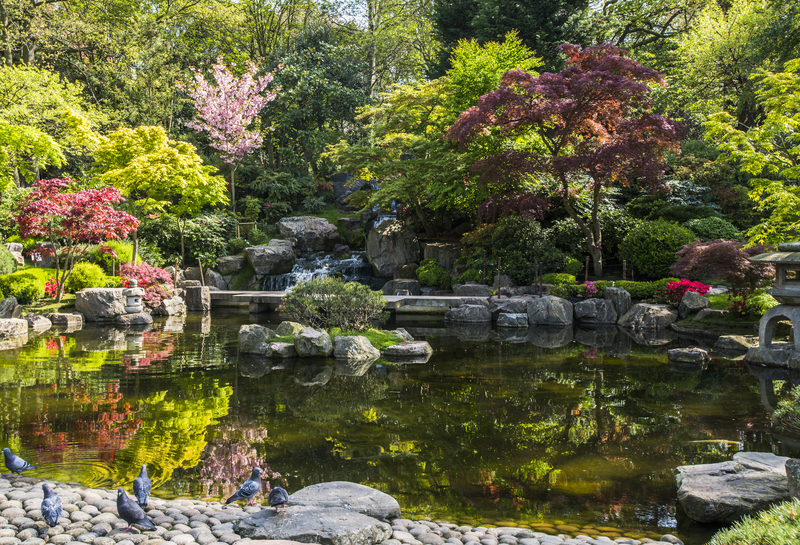Transforming Backyards into Climate Change Buffers
Posted on 23/09/2025
Transforming Backyards into Climate Change Buffers: Sustainable Solutions for Every Homeowner
Climate change and its adverse effects are becoming more evident with each passing season. From raging wildfires to unprecedented floods and heatwaves, our planet's natural balance is under increasing strain. Yet, amidst the global push for policy changes and renewable energy, individuals have a unique opportunity to make a significant impact at home. Transforming backyards into climate change buffers is not only doable--it's an essential step toward creating resilient communities and a healthier planet.

Why Turn Your Backyard Into a Climate Change Buffer?
The concept of using home landscapes as climate change buffers revolves around leveraging the natural functions of plants, soil, and eco-friendly design to boost resilience. Ecosystems, even on a small scale, can help:
- Absorb carbon dioxide (CO2) from the atmosphere
- Manage stormwater and prevent flooding
- Moderate extreme temperatures through shade and evapotranspiration
- Protect biodiversity by providing habitat for pollinators and other wildlife
- Improve soil health and water retention
By consciously designing backyards to serve these functions, homeowners become front-line actors in the fight against climate change.
Understanding Climate Change Buffers and Backyard Ecosystems
A climate change buffer is any system that can mitigate or adapt to environmental stressors caused or aggravated by our changing climate. In the residential context, it means designing sustainable backyards that help offset greenhouse gases, absorb excess rainwater, and provide micro-climates that counteract heat islands in urban and suburban environments.
Ecological Principles at Work
- Carbon Sequestration: Plants, especially trees and shrubs, capture and store carbon from the air, acting as natural "carbon sinks."
- Water Management: Healthy soils and diverse vegetation absorb rainfall and filter pollutants before water reaches storm drains or natural waterways, buffering against floods and droughts.
- Temperature Regulation: Strategically placed trees and groundcovers cool the surrounding air, reducing the need for energy-intensive air conditioning.
- Biodiversity Support: Mixed plantings attract pollinators, birds, and beneficial insects, boosting local ecosystem stability.
Step-by-Step Guide to Transforming Your Backyard Into a Climate Change Buffer
1. Assess Your Outdoor Space
Start by mapping your backyard's size, topography, sunlight exposure, and current vegetation. Identify drainage patterns, and note any problem areas prone to flooding or drought. Understanding your yard allows you to design effective interventions tailored to your local climate and soil conditions.
2. Prioritize Native and Climate-Resilient Plants
One of the most effective ways to create a backyard climate buffer is by planting a diverse array of native trees, shrubs, and perennials. Native species are adapted to local weather extremes, require less water and fertilizer, support local wildlife, and are more resistant to pests and disease.
- Trees: Choose shade-producing, long-lived species. Oaks, maples, and evergreens provide dense canopies and deep root systems, essential for carbon storage and erosion control.
- Shrubs: Layering shrubs under trees improves both aesthetics and ecological function. Native berry bushes, dogwoods, and sumacs are excellent choices.
- Groundcovers & Perennials: Fill in open spaces with drought-tolerant grasses, wildflowers, and ferns to reduce soil erosion, outcompete weeds, and retain moisture.
3. Incorporate Rain Gardens and Swales
Managing stormwater is a critical element in backyard climate adaptation. Rain gardens--shallow depressions planted with moisture-loving native plants--capture and filter runoff before it can cause flooding or pollution downstream. In larger yards, bioswales (vegetated channels) slow and direct excess rainwater, spreading it across your landscape for maximum absorption.
4. Avoid Chemical Inputs and Practice Organic Gardening
Synthetic fertilizers and pesticides can disrupt soil biology, leach into waterways, and undermine your climate buffer's ecological value. Instead, practice organic methods:
- Compost kitchen and yard waste to build soil health and sequester carbon
- Mulch to retain moisture and suppress weeds naturally
- Use integrated pest management and encourage beneficial insects
5. Install Green Infrastructure Features
- Green Roofs and Living Walls: For small yards or urban settings, these vertical and rooftop gardens provide insulation, reduce runoff, and create habitat.
- Permeable Paving: Substitute concrete paths or patios with permeable options (like gravel, permeable pavers, or spaced stepping stones surrounded by groundcover) to minimize runoff and increase water infiltration.
- Rain Barrels and Cisterns: Harvesting rainwater offsets potable water use and supports gardens during droughts.
6. Support Urban & Suburban Wildlife
Every backyard climate buffer can double as a wildlife refuge.
- Install bee hotels or birdhouses to shelter pollinators and birds
- Plant a succession of flowers for year-round nectar and pollen
- Leave brush piles or deadwood for beneficial insects and small mammals
7. Reduce Lawn Area and Mow Smartly
Traditional turf lawns offer little value as climate change buffers. Large expanses of lawn require frequent watering, fertilization, and mowing--activities that can actually contribute to greenhouse gas emissions. Reduce lawn area by replacing sections with native meadows, groundcover, or vegetable gardens. When you do maintain grass, mow it higher and less often to encourage deeper roots and drought resilience.
Designing for the Local Climate
Every region faces unique climate risks. A successful climate-smart backyard addresses the specific threats posed by your local weather and environmental trends.
Examples:
- Arid and Drought-Prone Areas: Focus on xeriscaping with low-water-use plants, rainwater harvesting, and thick mulching.
- Flood-Prone Regions: Emphasize rain gardens, permeable surfaces, and raised beds to improve drainage and absorb storms.
- Urban Heat Islands: Plant shade trees, use reflective mulch/paints, and create green roofs or walls to cool microclimates.
- Fire-Prone Zones: Prioritize fire-resistant plantings, create defensible space, and keep organic matter away from structures.
The Carbon Sequestration Potential: How Much Can Your Backyard Buffer?
According to the US Environmental Protection Agency, a mature tree can absorb up to 48 pounds of carbon dioxide per year. Even a modest suburban yard with a few trees and dense plantings can sequester hundreds of pounds of carbon annually. When multiplied across a neighborhood or city, backyard buffers become a vital piece of the broader climate action puzzle.
Additional Environmental Benefits
- Minimizing runoff protects rivers, lakes, and coastal ecosystems
- Supporting pollinators enhances local and global food security
- Improved soils and shade reduce home energy bills and cooling costs
- Enhanced biodiversity creates more beautiful, resilient landscapes
Social and Health Benefits of Climate-Friendly Backyards
Transforming your backyard into a climate change buffer isn't just good for the planet--it's good for people, too. Gardens and green spaces improve mental health, foster neighborhood connections, and offer opportunities for sustainable food production. Spending time in a thriving, resilient garden can reduce stress, encourage physical activity, and inspire a deeper connection to nature and climate stewardship.
Overcoming Barriers: Cost, Time, and HOAs
Many homeowners worry about the cost and effort of transforming their yards. However, a climate-ready landscape doesn't have to be installed all at once. Start with one section, such as swapping a patch of lawn for native plants or installing a rain barrel. Over time, small changes add up.
Those in communities with strict Homeowner Association (HOA) guidelines might face hurdles to removing lawns or installing alternative landscaping. However, increased awareness of the need for drought-tolerant and native plantings is leading many HOAs to reconsider their restrictions--especially as more regions face water shortages and climate stressors.
Community-Wide Impact: Linking Backyard Buffers
Backyards aren't isolated ecosystems; when neighbors collaborate, the benefits multiply. Entire blocks or neighborhoods can create wildlife corridors and "green infrastructure" networks that support pollinators, reduce urban temperatures, and significantly decrease local flooding risk.
- Host native plant swaps or workshops to inspire community action
- Share harvests from backyard gardens to promote food security
- Coordinate rain garden installations along shared property lines for maximum water absorption
Imagine a city where every backyard is part of a larger climate buffer--cooling the air, cleaning water, and supporting biodiversity on a regional scale!

Key Takeaways: How Every Homeowner Can Make a Difference
- Choose native, climate-resilient plants and plant a diversity of species
- Install rain gardens, swales, green roofs, or permeable surfaces to manage water
- Eliminate chemical inputs and build healthy soil with compost and mulch
- Support pollinators and local wildlife
- Reduce traditional lawn area
- Encourage your neighbors--shared action has a broader collective impact!
Conclusion: Your Backyard--A Powerful Climate Change Solution
Your backyard is more than just a personal oasis--it can be a functional part of the global movement to slow and adapt to climate change. By transforming ordinary home landscapes into climate change buffers, individual homeowners help sequester carbon, manage stormwater, boost biodiversity, and create healthier communities.
The shift to climate-friendly backyards doesn't have to be expensive or overwhelming. Start by planting a single native tree, swapping a strip of lawn for wildflowers, or building a simple rain garden. Over time, incremental actions become a powerful buffer against the challenges of a changing climate. As more homeowners take up this call, the collective impact will reverberate far beyond individual fences--paving the way for a cooler, greener, more resilient future for all.
By transforming your backyard into a climate change buffer, you are not just adapting to the new normal; you are actively shaping a better world for generations to come.

